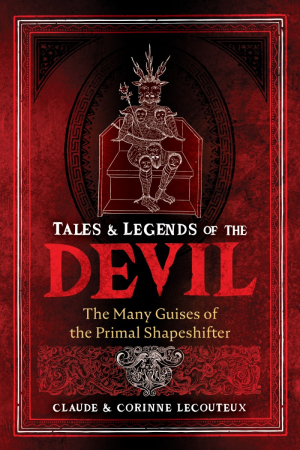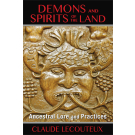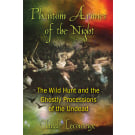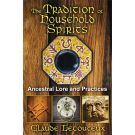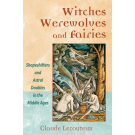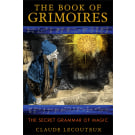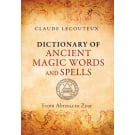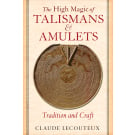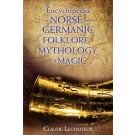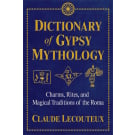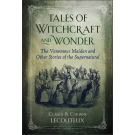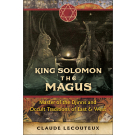Tales and Legends of the Devil
The Many Guises of the Primal Shapeshifter
By (Author) Claude Lecouteux
By (Author) Corinne Lecouteux
Availability:
In Stock
- Pages: 240
- Book Size: 6 x 9
- ISBN-13: 9781644116852
- Imprint: Inner Traditions
- On Sale Date: August 29, 2023
- Format: Hardcover Book
- Illustrations: 5 b&w illustrations
Explores the many forms and abilities of the devil in stories from around the world
Drawing on folk traditions from all over Europe, including Transylvanian Romania, Bulgaria, Albania, Switzerland, Italy, France, Scandinavia, Moravia, Bohemia, Lapland, and the Baltic countries, Claude and Corinne Lecouteux explore ancient tales and legends of the devil. They examine the devil’s shapeshifting powers and the symbolic implications of his often disfigured or animal-like appearance.
Drawing on folk traditions from all over Europe, including Transylvanian Romania, Bulgaria, Albania, Switzerland, Italy, France, Scandinavia, Moravia, Bohemia, Lapland, and the Baltic countries, Claude and Corinne Lecouteux explore ancient tales and legends of the devil. They examine the devil’s shapeshifting powers and the symbolic implications of his often disfigured or animal-like appearance.
• Draws on folk traditions from all over Europe, including Transylvanian Romania, Bulgaria, Albania, Switzerland, Italy, France, Scandinavia, and the Baltic countries
• Traces the devil’s shapeshifting powers back to their Vedic origins in ancient India and looks at his connections with witches and storm magic
• Reveals how many of the qualities and magical powers attributed to the devil were once those belonging to pagan gods
The devil has many more guises than the cliché red boogeyman named Lucifer or Satan who haunts Christianity. In some traditions the devil is sinister and cunning, while others portray him as an oaf who can easily be conned and evaded by anyone with an ounce of cleverness. In other tales and legends, he is the primal shapeshifter, and the Roma, also known as the gypsies, claimed his talents of metamorphosis were so strong he could even assume the appearance of a priest.
Drawing on folk traditions from all over Europe, including Transylvanian Romania, Bulgaria, Albania, Switzerland, Italy, France, Scandinavia, Moravia, Bohemia, Lapland, and the Baltic countries, Claude and Corinne Lecouteux explore the many forms and abilities of the devil in stories, tales, and legends throughout the ages. They trace the devil’s shapeshifting powers back to their Vedic origins in ancient India and look at his connections with witches, storm magic, and other magical events. They examine the symbolic implications of the appearance of the devil in these tales, such as how he is often either limping or disfigured with the legs or feet of a goat or other animals traditionally linked to the lower powers or passions. They explain how the devil’s limp or his goat-like feet reflect the prevalence in world mythology of the sacred nature of crippling injuries.
Peeling back the Christian veneer embedded in many tales and legends about the so-called Evil One, the authors ultimately reveal how many of the qualities and magical powers attributed to the devil were once those belonging to pagan gods, like the Lithuanian thunder god Perkūnas or the Titan Chronos, as well as to playful woodland spirits and the sometimes helpful, sometimes fearful fauns and satyrs of Greco-Roman mythology.
• Traces the devil’s shapeshifting powers back to their Vedic origins in ancient India and looks at his connections with witches and storm magic
• Reveals how many of the qualities and magical powers attributed to the devil were once those belonging to pagan gods
The devil has many more guises than the cliché red boogeyman named Lucifer or Satan who haunts Christianity. In some traditions the devil is sinister and cunning, while others portray him as an oaf who can easily be conned and evaded by anyone with an ounce of cleverness. In other tales and legends, he is the primal shapeshifter, and the Roma, also known as the gypsies, claimed his talents of metamorphosis were so strong he could even assume the appearance of a priest.
Drawing on folk traditions from all over Europe, including Transylvanian Romania, Bulgaria, Albania, Switzerland, Italy, France, Scandinavia, Moravia, Bohemia, Lapland, and the Baltic countries, Claude and Corinne Lecouteux explore the many forms and abilities of the devil in stories, tales, and legends throughout the ages. They trace the devil’s shapeshifting powers back to their Vedic origins in ancient India and look at his connections with witches, storm magic, and other magical events. They examine the symbolic implications of the appearance of the devil in these tales, such as how he is often either limping or disfigured with the legs or feet of a goat or other animals traditionally linked to the lower powers or passions. They explain how the devil’s limp or his goat-like feet reflect the prevalence in world mythology of the sacred nature of crippling injuries.
Peeling back the Christian veneer embedded in many tales and legends about the so-called Evil One, the authors ultimately reveal how many of the qualities and magical powers attributed to the devil were once those belonging to pagan gods, like the Lithuanian thunder god Perkūnas or the Titan Chronos, as well as to playful woodland spirits and the sometimes helpful, sometimes fearful fauns and satyrs of Greco-Roman mythology.
Translator’s Preface
Introduction
Chapter I
The Devil as Suitor
Chapter II
The Devil and His Family
Chapter III
The Swindled and Battered Devil
Chapter IV
In the Devil’s Service
Chapter V
A Visit to Hell
Chapter VI
The Devil and the Church
Chapter VII
Singular Tales
Appendix 1
Tale Types in this Book
Appendix 2
Index of Motifs Associated with the Devil
Notes
Bibliography
Index
Introduction
Chapter I
The Devil as Suitor
Chapter II
The Devil and His Family
Chapter III
The Swindled and Battered Devil
Chapter IV
In the Devil’s Service
Chapter V
A Visit to Hell
Chapter VI
The Devil and the Church
Chapter VII
Singular Tales
Appendix 1
Tale Types in this Book
Appendix 2
Index of Motifs Associated with the Devil
Notes
Bibliography
Index
Claude Lecouteux is a professor emeritus of medieval literature and civilization at the Sorbonne. He is the author of numerous books on medieval beliefs and magic, including Tales of Witchcraft and Wonder.
Corinne Lecouteux is a translator specializing in tales and legends. She is the coauthor with her husband, Claude, of Travels to the Otherworld and Other Fantastic Realms. The authors live in Paris.
Corinne Lecouteux is a translator specializing in tales and legends. She is the coauthor with her husband, Claude, of Travels to the Otherworld and Other Fantastic Realms. The authors live in Paris.
“In their majestic collection of folk stories about Satan, authors and curators Claude and Corinne Lecouteux unearth a truth that our culture translates into myth: we as a human community remain deeply affectionate toward our old gods. What in cinema is called Loki, Darth Vader, and Maleficent are the same archetypes that populate these Old-World legends in which our forebears were brave enough to call their antihero by his name. With the very able hand of translator Jon E. Graham, the Lecouteuxs have created a forbidden feast.” Mitch Horowitz, PEN Award–winning author of
Occult America and Uncertain Places
“How do you best the devil and live happily ever after? Read Claude and Corinne Lecouteux’s Tales and Legends of the Devil, stories from across Europe, and find out. Claude Lecouteux is a master of unearthing hidden treasures from the European tradition.” Arthur Versluis, author of The Secret History of Western Sexual Mysticism
“Humanity’s relationship to adversity personified and elucidated in stories teaches us the value of the cunning trickster. From either the vantage point of moral hygiene stories or the lack thereof, these stories show us the importance and folly of cunning, something we all need to be reminded of. Claude and Corinne have done a fabulous job.” Marcus McCoy, cofounder of the Viridis Genii Symposium and esoteric blacksmith at Troll Cunning Forge
“Claude Lecouteux has written extensively and meticulously on the supernatural figures that appear in what is often called ‘the lower mythology’ of the Middle Ages and has shown how these same figures (still) haunt our own world. More than twenty of Claude Lecouteux’s books (including several coauthored by his wife, Corinne) have been translated and published by Inner Traditions over the past fifteen years. Why did I feel compelled to write a preface for this particular book? Perhaps because ‘the devil made me do it.’” Jon E. Graham, award-winning translator of the Bavarian illuminati
“How do you best the devil and live happily ever after? Read Claude and Corinne Lecouteux’s Tales and Legends of the Devil, stories from across Europe, and find out. Claude Lecouteux is a master of unearthing hidden treasures from the European tradition.” Arthur Versluis, author of The Secret History of Western Sexual Mysticism
“Humanity’s relationship to adversity personified and elucidated in stories teaches us the value of the cunning trickster. From either the vantage point of moral hygiene stories or the lack thereof, these stories show us the importance and folly of cunning, something we all need to be reminded of. Claude and Corinne have done a fabulous job.” Marcus McCoy, cofounder of the Viridis Genii Symposium and esoteric blacksmith at Troll Cunning Forge
“Claude Lecouteux has written extensively and meticulously on the supernatural figures that appear in what is often called ‘the lower mythology’ of the Middle Ages and has shown how these same figures (still) haunt our own world. More than twenty of Claude Lecouteux’s books (including several coauthored by his wife, Corinne) have been translated and published by Inner Traditions over the past fifteen years. Why did I feel compelled to write a preface for this particular book? Perhaps because ‘the devil made me do it.’” Jon E. Graham, award-winning translator of the Bavarian illuminati
Magic / Folklore
“In their majestic collection of folk stories about Satan, authors and curators Claude and Corinne Lecouteux unearth a truth that our culture translates into myth: we as a human community remain deeply affectionate toward our old gods. What in cinema is called Loki, Darth Vader, and Maleficent are the same archetypes that populate these Old-World legends in which our forebears were brave enough to call their antihero by his name. With the very able hand of translator Jon E. Graham, the Lecouteuxs have created a forbidden feast.”
–MITCH HOROWITZ, PEN Award–winning author of Occult America and Uncertain Places
The devil has many more guises than the cliché red boogeyman named Lucifer or Satan who haunts Christianity. In some traditions the devil is sinister and cunning, while others portray him as an oaf who can easily be conned and evaded by anyone with an ounce of cleverness. In other tales and legends, he is the primal shapeshifter, and the Roma, also known as the gypsies, claimed his talents of metamorphosis were so strong he could even assume the appearance of a priest.
Drawing on folk traditions from all over Europe, including Transylvanian Romania, Bulgaria, Albania, Switzerland, Italy, France, Scandinavia, Moravia, Bohemia, Lapland, and the Baltic countries, Claude and Corinne Lecouteux explore the many forms and abilities of the devil in stories, tales, and legends throughout the ages. They trace the devil’s shapeshifting powers back to their Vedic origins in ancient India and look at his connections with witches, storm magic, and other magical events. They examine the symbolic implications of the appearance of the devil in these tales, such as how he is often either limping or disfigured with the legs or feet of a goat or other animals traditionally linked to the lower powers or passions. They explain how the devil’s limp or his goat-like feet reflect the prevalence in world mythology of the sacred nature of crippling injuries.
Peeling back the Christian veneer embedded in many tales and legends about the so-called Evil One, the authors ultimately reveal how many of the qualities and magical powers attributed to the devil were once those belonging to pagan gods, like the Lithuanian thunder god Perkūnas or the Titan Chronos, as well as to playful woodland spirits and the sometimes helpful, sometimes fearful fauns and satyrs of Greco-Roman mythology.
CLAUDE LECOUTEUX is a professor emeritus of medieval literature and civilization at the Sorbonne. He is the author of numerous books on medieval beliefs and magic, including Tales of Witchcraft and Wonder.
CORINNE LECOUTEUX is a translator specializing in tales and legends. She is the coauthor with her husband, Claude, of Travels to the Otherworld and Other Fantastic Realms. The authors live in Paris.
“In their majestic collection of folk stories about Satan, authors and curators Claude and Corinne Lecouteux unearth a truth that our culture translates into myth: we as a human community remain deeply affectionate toward our old gods. What in cinema is called Loki, Darth Vader, and Maleficent are the same archetypes that populate these Old-World legends in which our forebears were brave enough to call their antihero by his name. With the very able hand of translator Jon E. Graham, the Lecouteuxs have created a forbidden feast.”
–MITCH HOROWITZ, PEN Award–winning author of Occult America and Uncertain Places
The devil has many more guises than the cliché red boogeyman named Lucifer or Satan who haunts Christianity. In some traditions the devil is sinister and cunning, while others portray him as an oaf who can easily be conned and evaded by anyone with an ounce of cleverness. In other tales and legends, he is the primal shapeshifter, and the Roma, also known as the gypsies, claimed his talents of metamorphosis were so strong he could even assume the appearance of a priest.
Drawing on folk traditions from all over Europe, including Transylvanian Romania, Bulgaria, Albania, Switzerland, Italy, France, Scandinavia, Moravia, Bohemia, Lapland, and the Baltic countries, Claude and Corinne Lecouteux explore the many forms and abilities of the devil in stories, tales, and legends throughout the ages. They trace the devil’s shapeshifting powers back to their Vedic origins in ancient India and look at his connections with witches, storm magic, and other magical events. They examine the symbolic implications of the appearance of the devil in these tales, such as how he is often either limping or disfigured with the legs or feet of a goat or other animals traditionally linked to the lower powers or passions. They explain how the devil’s limp or his goat-like feet reflect the prevalence in world mythology of the sacred nature of crippling injuries.
Peeling back the Christian veneer embedded in many tales and legends about the so-called Evil One, the authors ultimately reveal how many of the qualities and magical powers attributed to the devil were once those belonging to pagan gods, like the Lithuanian thunder god Perkūnas or the Titan Chronos, as well as to playful woodland spirits and the sometimes helpful, sometimes fearful fauns and satyrs of Greco-Roman mythology.
CLAUDE LECOUTEUX is a professor emeritus of medieval literature and civilization at the Sorbonne. He is the author of numerous books on medieval beliefs and magic, including Tales of Witchcraft and Wonder.
CORINNE LECOUTEUX is a translator specializing in tales and legends. She is the coauthor with her husband, Claude, of Travels to the Otherworld and Other Fantastic Realms. The authors live in Paris.



